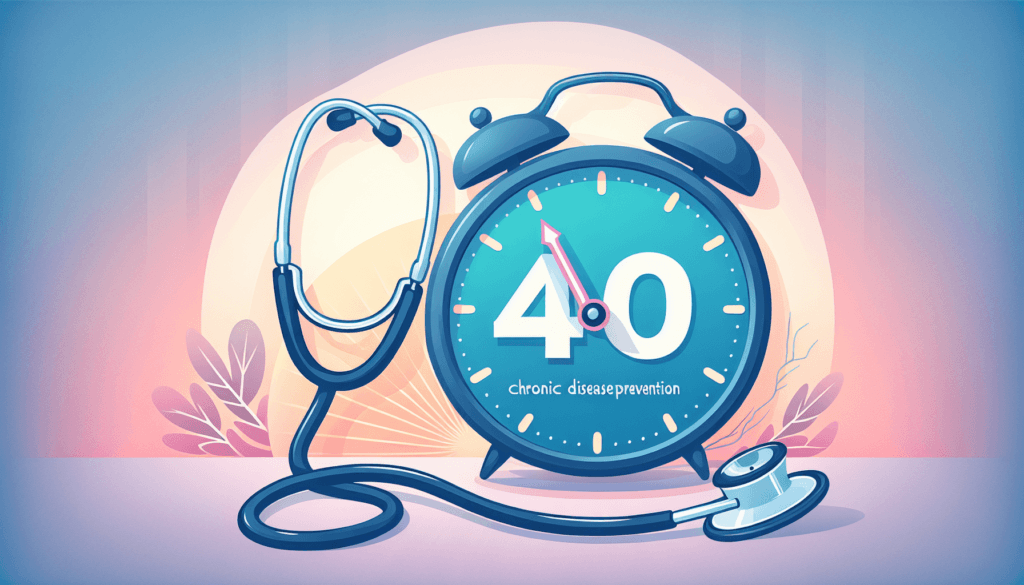Have you ever wondered why the decade of your 40s is often regarded as a critical period for chronic disease prevention?

This image is property of images.pexels.com.
Table of Contents
Overview
As you transition into your 40s, your body’s metabolism and physical resilience begin to change. It’s crucial to understand the importance of proactive health measures to prevent chronic diseases. This period serves as a vital opportunity to implement lifestyle changes that can significantly impact your health trajectory.
Thesis Statement
“A Chronic Disease Prevention Guide for Your 40s: Navigating the Critical Decade” explores the essential strategies and lifestyle practices to mitigate the risk of chronic diseases. By prioritising your health now, you can enjoy greater wellness and quality of life in the years to come.
Historical Context
Historically, the 40s have been seen as a pivotal decade for health. Extensive research indicates that lifestyle choices made during this period can either predispose or protect individuals from chronic conditions in later years. For instance, the Framingham Heart Study, which began in the late 1940s, provided groundbreaking data illustrating the correlation between lifestyle factors in midlife and chronic disease onset.
Current Trends
Today, there is increasing evidence highlighting the significance of disease prevention strategies in middle age. Modern preventive health practices, such as routine screenings, balanced diets, and regular physical activity, have proven effective in lowering the risk of chronic ailments. Specific examples include the adoption of Mediterranean and DASH diets, which are gaining popularity for their role in reducing heart disease and hypertension.

This image is property of images.pexels.com.
Key Concepts and Definitions
Chronic Diseases
Chronic diseases are long-lasting conditions that usually progress slowly. Common examples include cardiovascular disease, diabetes, arthritis, and various forms of cancer. These conditions often require ongoing medical attention and can significantly impair daily living activities.
Preventive Health
Preventive health refers to actions taken to prevent diseases rather than treating them once they occur. This approach includes lifestyle modifications, vaccinations, and regular health screenings to detect and manage potential health risks early.
Subtopics for Chronic Disease Prevention in Your 40s
Diet and Nutrition
A balanced diet is foundational to preventing chronic diseases. Your nutritional intake should comprise a variety of fruits, vegetables, whole grains, lean proteins, and healthy fats. Reducing the intake of processed foods, sugars, and saturated fats is equally essential.
Mediterranean Diet
The Mediterranean diet is rich in fruits, vegetables, nuts, seeds, beans, and olive oil. This diet has been associated with a reduced risk of heart disease, Alzheimer’s, and certain cancers. A study published in the New England Journal of Medicine found that adherence to a Mediterranean diet lowered the incidence of major cardiovascular events by 30%.
DASH Diet
The Dietary Approaches to Stop Hypertension (DASH) diet focuses on reducing sodium intake and increasing consumption of potassium, calcium, and magnesium-rich foods. This dietary plan can help lower blood pressure and reduce the risk of cardiovascular diseases.
Physical Activity
Regular physical activity is crucial for maintaining cardiovascular health, weight management, and muscle strength. Aim for at least 150 minutes of moderate-intensity exercise or 75 minutes of vigorous-intensity exercise per week. Activities such as walking, swimming, and cycling are excellent choices.
Example 1: Cardiovascular Benefits
A study published in the Journal of the American College of Cardiology illustrated that individuals who engaged in regular physical activity had a 35% reduced risk of developing heart disease compared to those with a sedentary lifestyle. The data used in this study provides robust evidence of the cardiovascular benefits linked to regular exercise.
Example 2: Diabetes Prevention
Engaging in physical activity can also play a significant role in preventing Type 2 diabetes. According to data from the Diabetes Prevention Program, individuals who incorporated at least 150 minutes of exercise per week into their routine reduced their risk of diabetes by 58% compared to those who did not.
Mental Health and Stress Management
Mental health is often overlooked in chronic disease prevention, but it is equally important. High-stress levels and poor mental health can predispose you to various chronic conditions, including cardiovascular diseases and diabetes.
Mindfulness and Meditation
Incorporating mindfulness and meditation into your daily routine can help reduce stress levels and improve overall mental well-being. A study published in JAMA Internal Medicine found that mindfulness meditation programs improved anxiety, depression, and pain in participants.
Cognitive Behavioral Therapy (CBT)
CBT is an effective method for managing mental health issues. This form of therapy helps you develop coping strategies to deal with stress and anxiety, which can be beneficial for long-term mental health.
Regular Health Screenings
Regular health screenings are vital for the early detection and management of chronic diseases. It is recommended to undergo routine checks for blood pressure, cholesterol levels, blood glucose, and certain cancers.
Example 1: Blood Pressure Monitoring
Routine blood pressure checks can help detect hypertension early. According to the American Heart Association, uncontrolled hypertension can lead to severe complications such as heart attack, stroke, and kidney damage. Regular monitoring allows for timely intervention and management.
Example 2: Cancer Screenings
Screenings for cancers such as breast, colorectal, and skin cancer are essential. Early detection of these conditions significantly improves treatment outcomes. For instance, colonoscopies to detect colorectal cancer are recommended starting at age 45, as advised by the American Cancer Society.
Smoking and Alcohol Consumption
Reducing or eliminating smoking and excessive alcohol consumption is fundamental to chronic disease prevention. Smoking is a major risk factor for lung cancer, heart disease, and stroke, while excessive alcohol intake can lead to liver disease, hypertension, and other health issues.
Quitting Smoking
Quitting smoking is one of the most influential steps you can take to improve your health. A study by the Center for Disease Control and Prevention (CDC) shows that smokers who quit by age 40 reduce their risk of dying from smoking-related diseases by approximately 90%.
Moderating Alcohol Intake
Moderation is key when it comes to alcohol consumption. The Dietary Guidelines for Americans recommend up to one drink per day for women and two drinks per day for men. Excessive alcohol intake is linked to various chronic diseases, including liver cirrhosis, hypertension, and certain cancers.
Sleep and Rest
Adequate sleep is essential for your body to repair and regenerate. Chronic sleep deprivation is linked to various health problems, such as obesity, cardiovascular disease, and impaired immune function.
Importance of Sleep Hygiene
Practicing good sleep hygiene can improve the quality and duration of your sleep. This includes maintaining a regular sleep schedule, creating a restful environment, and avoiding screen exposure before bedtime.
Case Study: Sleep and Heart Health
A study in the European Heart Journal found that individuals who reported consistent quality sleep patterns had a 22% lower risk of developing heart disease compared to those with irregular sleep habits.

This image is property of images.pexels.com.
Compare Different Points of View
Conventional Medicine vs. Integrative Medicine
Conventional medicine emphasizes diagnosis and treatment of diseases using pharmaceutical interventions, while integrative medicine combines conventional methods with alternative therapies to focus on preventive care and overall well-being.
| Criteria | Conventional Medicine | Integrative Medicine |
|---|---|---|
| Approach | Treat symptoms | Treat whole person (body, mind, spirit) |
| Methods | Pharmaceutical interventions | Combination of pharmaceuticals and natural therapies |
| Focus | Disease management | Disease prevention and health optimization |
| Interaction | Patient-physician relationship | Collaborative patient-healthcare provider relationship |
| Evidence | Clinical trials and scientific research | Mixed-method research including anecdotal evidence |
Impact Assessment
Integrative medicine often results in better patient outcomes due to its holistic approach. However, some critics argue that the lack of rigorous scientific evaluation for certain alternative therapies can lead to skepticism. Conventional medicine is widely accepted due to its evidence-based approach but may not always address the root causes of chronic diseases. Evaluating these perspectives can provide a balanced view to help you make informed decisions about your health care approach.
Future Directions and Implications
Predictions
In the coming years, advancements in health technology, personalized medicine, and genetic screening are expected to revolutionize chronic disease prevention. Future trends will likely include increased accessibility to wearable health devices that monitor vital signs, enabling individuals to take proactive measures based on real-time data.
Implications
The implications of these advancements are profound for both the health care industry and individuals. Enhanced monitoring and personalized interventions can lead to significant reductions in chronic disease incidence and improve overall health outcomes. For example, the use of artificial intelligence in predictive analytics could enable healthcare providers to offer more precise recommendations for lifestyle changes tailored to individual needs.

Conclusion
In summary, your 40s represent a crucial decade for implementing preventive measures to mitigate the risk of chronic diseases. By focusing on balanced nutrition, regular physical activity, mental health, routine health screenings, and lifestyle modifications such as quitting smoking and moderating alcohol intake, you can significantly enhance your overall well-being. The evidence supports that proactive health practices are key to a healthier, longer life.
To close, chronic disease prevention is an ongoing journey that requires dedication and informed decisions. As you reflect on the strategies discussed, consider their applicability in your daily life and the long-term benefits they can offer. What preventive measures do you find most compelling and are you willing to incorporate them into your routine?
Engage
We encourage you to further investigate related topics using reputable sources and consider consulting healthcare professionals for personalized advice. Staying informed will empower you to make choices that best serve your health needs.
Credible Sources
- American Heart Association. (2021). Hypertension Statistics.
- CDC. (2020). Benefits of Quitting Smoking.
- Diabetes Prevention Program. (2002). Results of the DPP Study.
- European Heart Journal. (2020). Sleep Patterns and Heart Disease.
- JAMA Internal Medicine. (2014). Mindfulness Meditation Course.
- New England Journal of Medicine. (2013). The Mediterranean Diet and Cardiovascular Risk.
- The American Cancer Society. (2021). Colorectal Cancer Screening Guidelines.
By citing these authoritative resources, you can validate the credibility of the information presented and gain further insights into the importance of chronic disease prevention during your 40s.
Your guide to preventative health screenings you should get in your 40s

